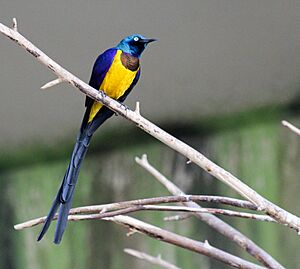Golden-breasted starling facts for kids
Quick facts for kids Golden-breasted starling |
|
|---|---|
 |
|
| Conservation status | |
| Scientific classification | |
| Synonyms | |
|
The golden-breasted starling (Lamprotornis regius) is also known as the royal starling. This beautiful bird is a medium-sized passerine, which means it's a type of perching bird. It belongs to the starling family.
Contents
Types of Golden-breasted Starlings
These birds have two main types, or subspecies:
- Lamprotornis regius magnificus (named by van Someren in 1924)
- Lamprotornis regius regius (named by Reichenow in 1879)
Where Golden-breasted Starlings Live
The golden-breasted starling lives in a very large area of Northeastern Africa. You can find them in countries like Somalia, Ethiopia, Kenya, and northern Tanzania.
These birds like to live in open areas. Their favorite places include grassland, savannah, and areas with lots of shrubland. They also enjoy dry-thorn forests and thickets of acacia trees.

How They Look
The Lamprotornis regius can grow to be about 35 centimeters (about 14 inches) long. Adult birds have a shiny metallic green head and upper back. Their chest and belly are a bright golden yellow.
Their bill and legs are dark, and their eyes have a white iris. Their wings, lower back, neck, and long tail feathers are a beautiful metallic violet-blue color. Both male and female starlings look very similar. Young starlings are not as brightly colored as the adults.
Golden-breasted Starling Behavior
Golden-breasted starlings are very social animals. They usually live in groups of three to twelve birds. You can often see adult birds from January to June and again from August to November. January is when they are most active.
Breeding and Life Cycle
These starlings shed their old feathers and grow new ones once a year. This happens after their breeding season. Golden-breasted starlings are monogamous, meaning they stay with one partner.
The female usually lays between three and five eggs. These eggs are pale green with small red speckles. They often build their nests in holes in trees. Sometimes, they use old tree holes that woodpeckers have left behind. The nest itself is made from leaves, roots, and other plant materials. The whole family group works together to raise the young. They help by finding food and gathering materials for the nest.
What They Eat
Unlike some other types of starlings that mostly eat fruit, golden-breasted starlings mainly eat insects and termites. Adult birds are good at catching insects while flying. They also dig into termite mounds to find their prey. Sometimes, their diet includes snails, spiders, crabs, or even small animals like lizards.


